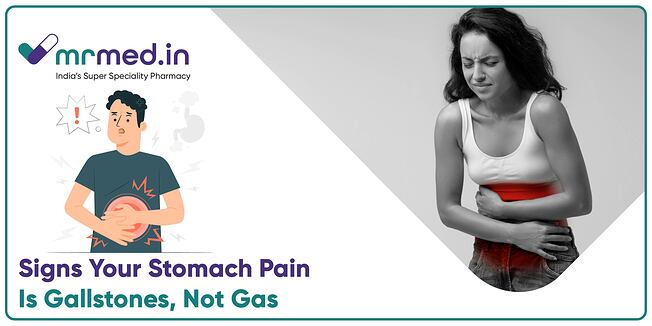mrmedonlinepharmacy: Gallstones or Gas? What Your Stomach Pain After Eating Might Be Telling You
Ever felt like your belly is throwing a tantrum after a hearty meal? That bloated, cramping pain? You’re not alone. Many people shrug it off as simple gas, but what if it’s something more serious, like gallstones? The symptoms can feel surprisingly similar, but the consequences can be worlds apart. Let’s break it down in a way that your gut (and your common sense) will thank you for.Why does my stomach hurt right after eating?There’s nothing like that post-meal satisfaction… until the ache kicks in. Pain after eating can be your body’s way of saying, “Something’s not quite right.” Often, it’s gas—especially if you’ve gobbled down food too quickly, consumed fizzy drinks, or overindulged in fatty meals.However, when this discomfort becomes persistent, sharper, or occurs in the upper right abdomen, it might be pointing to gallstones. These little deposits of hardened bile can block your gallbladder ducts and mess up digestion.How do I know if it's gas or something more serious?Here’s the key difference: gas pain tends to come and go, and it often moves around. It might feel like pressure or bloating and can be relieved by passing wind or going to the toilet. On the flip side, gallstone pain—also called a gallbladder attack—is more stubborn.It usually strikes under the ribs on the right side, can radiate to the back or shoulder, and lasts longer, anywhere from 30 minutes to several hours. There’s often nausea, and fatty meals tend to make things worse. If you’ve noticed these symptoms more than once, it’s time to dig deeper.What causes gallstones to form?Gallstones develop when bile has too much cholesterol or not enough bile salts. This imbalance causes particles to clump together and form stones. Risk factors include being overweight, pregnancy, rapid weight loss, and eating a high-fat, low-fibre diet.Women are more likely to develop them, especially after 40. Genetics can also play a role. If your mum or grandmother had gallbladder issues, keep an eye out.Can diet and lifestyle trigger stomach pain?Absolutely. Certain foods can wreak havoc on your digestive system, whether it’s from gas or gallstones. Rich, greasy meals tend to stimulate the gallbladder more, which can lead to painful spasms if stones are present. Meanwhile, beans, cabbage, soft drinks, and artificial sweeteners are common gas culprits.Staying active, drinking plenty of water, and eating a balanced diet full of fruits, vegetables, and whole grains can significantly reduce the risk of both gas and gallstones.What are the red flags I shouldn't ignore?If your stomach pain is paired with any of these, don’t wait: Persistent pain in the upper right abdomen Pain that worsens after eating fatty foods Yellowing of the skin or eyes (jaundice) Fever with chills Nausea or vomiting that won’t go away These could signal a blocked bile duct or an inflamed gallbladder, both of which need medical attention right away.Can gas pains be mistaken for gallbladder issues?Yes, and that’s what makes diagnosis tricky. Gas pain can mimic gallstone symptoms, especially when it’s intense. However, gas is more likely to fluctuate and improve with movement or position changes.Gallbladder pain is often more severe, constant, and doesn’t improve with antacids or passing wind. If pain becomes a pattern, keep a diary and discuss it with your doctor.Is there a way to prevent gallstones naturally?Prevention starts in your kitchen. Choose healthy fats like those found in nuts, avocados, and olive oil. Avoid crash diets; they increase cholesterol in your bile. Eat smaller, more frequent meals and maintain a healthy weight.Some people benefit from fibre-rich foods and regular physical activity. And if you're prone to digestive issues, cutting back on processed and fried foods is a smart move.When should I see a doctor about my symptoms?If stomach pain is disrupting your life or linked with other symptoms like nausea, fever, or changes in stool colour, consult a professional. Don’t self-diagnose or rely solely on home remedies. Imaging tests like ultrasounds can easily detect gallstones.Plus, catching the problem early could help you avoid surgery or complications down the road.What treatments are available if it’s gallstones?The treatment depends on how severe your symptoms are. Many people live with silent gallstones, which don’t need immediate action. But if pain becomes frequent, your doctor may suggest medications to relieve it.In some cases, surgery to remove the gallbladder might be necessary. A common prescription includes Udiliv 300mg Tablet, which contains Ursodeoxycholic Acid. It helps dissolve certain types of gallstones and improve bile flow.Never start medication without proper consultation. Your doctor will decide what’s best based on your overall health and the type of stones you have.Final thoughtsWhether it’s a bubbly belly or a stubborn ache, your stomach’s trying to tell you something. Ignoring frequent post-meal pain won’t make it go away. Listen to your body, take note of your diet, and don’t hesitate to seek help.Remember, something as common as gas can easily mask a deeper issue. Being aware, proactive, and informed is your best line of defence.Also, if you're experiencing discomfort after meals, exploring a guide to acid reflux symptoms might help uncover more about what’s really going on.


